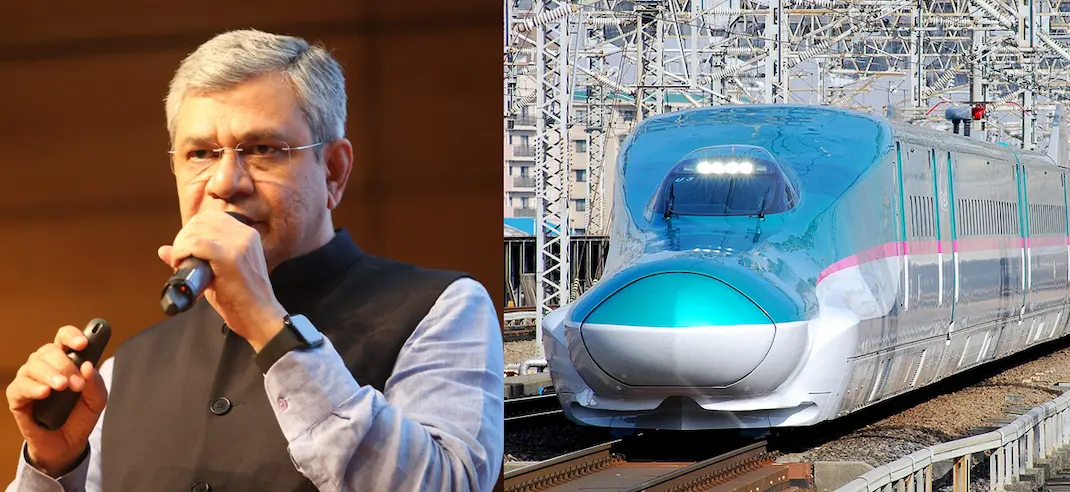
Mumbai-Ahmedabad Bullet Train project hits major milestones with 406 km built and tunnels nearly done, promising faster travel and modern rail infrastructure.
A Giant Leap in Indian Railways
Mumbai-Ahmedabad Bullet Train Project – India’s dream of high-speed rail travel is quickly becoming reality. The Mumbai-Ahmedabad Bullet Train project, officially known as the Mumbai-Ahmedabad High-Speed Rail (MAHSR), is making rapid progress. Railway Minister Ashwini Vaishnaw recently announced in Parliament that 406 kilometres of foundation work has already been completed out of the total 508 km stretch.
This ambitious project is India’s first bullet train corridor and is being built with technical and financial help from Japan. Once finished, the train will run at speeds of up to 320 km/h, cutting travel time between Mumbai and Ahmedabad from 7 hours to just about 2 hours.
The bullet train will not only improve travel but also boost regional development, create jobs, and showcase India’s ability to build world-class infrastructure.
Construction Milestones: Stations, Bridges, and Tunnels
The bullet train project is moving fast across both Gujarat and Maharashtra. Here are some key updates:
- Track laying has started on 127 km of viaduct, which is the elevated track structure the train will run on.
- Piers (vertical supports) have been completed across 395 km, and girders (horizontal beams) have been cast and launched over 300 km.
- Out of 12 planned stations, foundation work is done at 8 stations in Gujarat-including Vapi, Surat, Vadodara, and Ahmedabad. In Maharashtra, work is ongoing at Thane, Virar, and Boisar.
- Excavation at Mumbai’s Bandra Kurla Complex (BKC) station is nearly complete, and the base slab is being cast.
- 16 river bridges have been completed, and work is progressing on 9 more, including major bridges over the Narmada, Tapti, and Sabarmati rivers.
- Depots for train maintenance are being built at Thane, Surat, and Sabarmati.
One of the most exciting engineering feats is the 21 km undersea tunnel between Mumbai and Thane. A 4 km tunnel section between Ghansoli and Shilphata in Maharashtra is already finished, and the only tunnel in Gujarat is complete.
Investment and Impact: Jobs, Technology, and Progress
The bullet train project has already seen an investment of ₹78,839 crore as of June 2025. This massive infrastructure effort is not just about trains, it’s about transforming India’s transport future.
Here’s how the project is making an impact:
- Employment: Thousands of jobs have been created directly and indirectly through construction, material supply, and services.
- Technology Transfer: India is learning from Japan’s Shinkansen system, one of the world’s most advanced high-speed rail networks.
- Environmental Clearances: All required land (1,389.5 hectares) has been acquired, and clearances for wildlife, forest, and coastal zones have been secured.
- Noise Barriers: These are being installed along the route to reduce sound pollution during train operations.
The project is complex and technology-intensive, involving civil structures, electrical systems, signalling, and the supply of trainsets. Final timelines and costs will be confirmed once all these components are completed.
What This Means for India’s Future
The Mumbai-Ahmedabad Bullet Train is more than just a transport project-it’s a symbol of India’s progress. It shows how the country is embracing modern technology, improving connectivity, and aiming for global standards in infrastructure.
Once operational, the bullet train will:
- Reduce travel time dramatically
- Encourage business and tourism between Mumbai and Ahmedabad
- Set the stage for future high-speed rail corridors across India
- Inspire confidence in India’s ability to deliver large-scale projects
This project also aligns with the government’s “Make in India” initiative. While the bullet train uses Japanese technology, India is also developing its own semi-high-speed trains like the Vande Bharat Express, which are already running across the country.
Final Thoughts
India’s first bullet train (Mumbai-Ahmedabad Bullet Train) is no longer just a dream, it’s speeding toward reality. With major construction milestones achieved and tunnels nearing completion, the Mumbai-Ahmedabad corridor is on the fast track to becoming a landmark in Indian transportation.
As Minister Vaishnaw said, the Mumbai-Ahmedabad Bullet Train is not just about speed, it’s about building a new future for India. And that future is arriving faster than ever.
Also read – India’s First Bullet Train Station in Surat Nears Completion: A Game-Changer for High-Speed Rail
Rudrastra: India’s 4.5-KM Freight Train That Redefined Asian Rail Logistics
Stay informed with the latest news and updates – only on Rapido Updates.